 |
||
|
||
| ||
TABLE OF CONTENTSEvents in 3D graphics world, to be more exact in the 3D industry, are getting intense again. AMD will launch new products by the end of March. Being aware of it beforehand (to be more exact, suspecting that the 8800 GTX will be overthrown), NVIDIA is preparing updated products in the same segment, but with different combinations of frequencies, pipelines, and memory buses. So, we'll soon see battles between marketing departments, fans, and sales managers. Be reminded though that these battles will be fought for the purse of potential users of the new video cards. We should keep in mind that the market of video cards is already overheated. Will the new products be very popular? - The question is open. The 8800 GTX cards sell very well, despite their very high prices. But will their owners, which cards are not even dusty, upgrade them for a better model? And what about fixing multiple bugs in drivers? We wrote about them many times. - We'll wait and see. As for now, let's return to our muttons, to what we already have. Here is the current situation: various GeForce 8800 GTX cards with labels from different vendors, but manufactured at a couple of plants by NVIDIA's orders. Even though the reference cooling system is very efficient, none of NVIDIA's partners has even tried to equip these cards with their own solutions, anything special and interesting. And finally we can see a changed design in a product from EVGA. It lacks water cooling. But its frequencies are still raised. Engineers just enlarged the heat exchange surface at the cost of the cooler enclosure. They installed an additional heatsink at the back of the card. Everything else is the same. Of course, the company selects samples that can work at increased frequencies. We know that the price of this product is higher by $45. Peculiarities of this card will be described below. Our today's article will also include a review of the 8800 GTX from Palit. Running a few steps forward, I can say that it's a regular GTX card without any individual peculiarities. But our readers may like its price. These cards are currently the most powerful 3D accelerators for games.
Video Cards
Our examination proved that all the cards were indeed based on the same PCB. That is they are typical representatives of reference cards. I repeat that all such cards are currently not manufactured by NVIDIA partners. The Californian company places orders at third-party plants and then sells ready cards to its partners. That's why all 8800 GTX cards are as like as two peas. Except for overclocked models, of course - they have already appeared on the market. Even in this case, they differ only in raised frequencies, the cards preserve their reference design. However, the product from EVGA has a unique cooler. It will be described below. There have recently appeared GeForce 8800 cards with green PCBs. A number of users, inspired by some conjectures and fantasies, interpreted this change of color (from black to green) as a bugfix. They broadcast in forums that all black cards are buggy. They are ABSOLUTELY WRONG! Only the first lot of cards was defective (these cards are long gone!) They were called back and replaced. So don't trust these fantasies and buy GeForce 8800 GTX with a PCB of any color. Why did NVIDIA decide to roll back to the original green color - the reason is simple: a lion's share of such cards is manufactured by Flextronics - this plant traditionally manufactures cards lacquered green. The share of the other plant, which manufactures black cards, has been reduced. That's all. It should be noted that EVGA products, including this card, enjoy the 3-year warranty.
There is a company logo at the side of the cooler for modders and owners of PC cases with windows.
All these cards have TV-Out with a unique jack. You will need a special bundled adapter to output video to a TV-set via S-Video or RCA You can read about the TV-Out in more detail here. Analog monitors with d-Sub (VGA) interface are connected with special DVI-to-d-Sub adapters. Maximum resolutions and frequencies:
What concerns MPEG2 playback features (DVD-Video), we analyzed this issue in 2002. Little has changed since that time. CPU load during video playback on all modern video cards does not exceed 25%. What concerns HDTV and other trendy video features, we are going to sort them out as soon as possible. Both cards require additional power supply (via TWO CONNECTORS!), so each card has two black 6-pin connectors. In case your PSU does not have cables with such connectors, the bundle includes two splitters to connect to any Molex. Now about the cooling systems.
We monitored temperatures of these cards using RivaTuner (written by A.Nikolaychuk AKA Unwinder) and obtained the following results:
Palit GeForce 8800 GTX 768MB PCI-E EVGA e-GeForce 8800 GTX 768MB ACS3 Edition PCI-E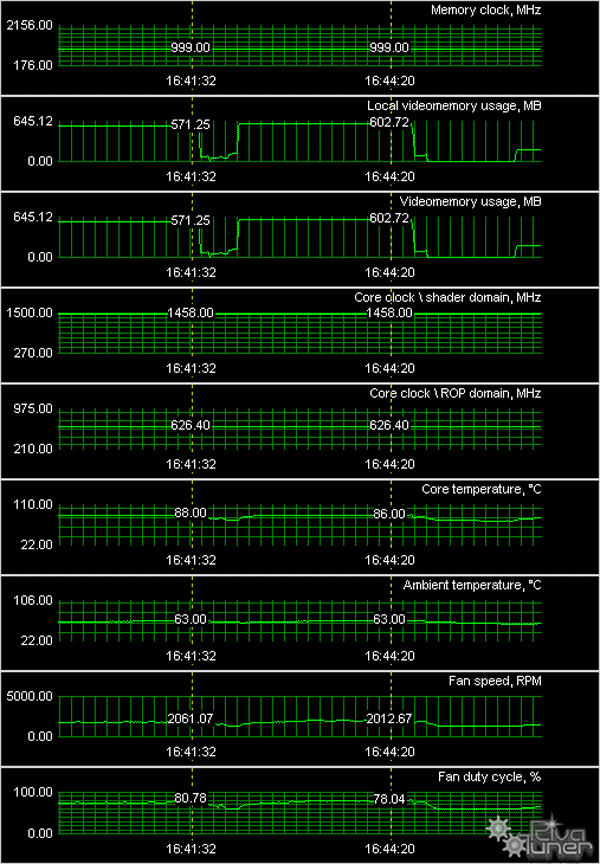 Even when the core is overclocked to 625 MHz, its temperature does not cross the dangerous line - I've already mentioned it. And fan speed does not grow much, so there is practically no noise.
Bundle
Packages
Installation and DriversTestbed configuration:
VSync is disabled.
Test results: performance comparisonWe used the following test applications:
Video cards' performance
If you understand 3D graphics, you may draw your own conclusions from the diagrams below. If you are interested in our comments on test results, you may read them after each test. What concerns beginners and those who just started to look for a video card, we shall include some detailed explanations. Firstly, you should look through our reference materials on modern video cards and their GPUs. Note operating frequencies, support for modern technologies (shaders), as well as a pipeline architecture. You should understand that the 8800 family of accelerators abolished the notion of a pipeline. These cards have streaming processors, which process shader commands in a game. Texture units process pixels (applying textures, filtering) by themselves, that is the processes are fully divided. Data are written into a memory buffer, as always, only after texture operations. The old procedure was to take a triangle, calculate it with shader commands, apply texture(s), filter it, and send it along; this procedure is not used anymore. It's up to a driver to decide what to do for each streaming processor. The same applies to texture units.
ATI RADEON X1300-1600-1800-1900 ReferenceNVIDIA GeForce 7300-7600-7800-7900-8800 ReferenceSecondly, if you have just faced the problem of choosing a video card and are at a loss, our 3D-Video section offers articles about 3D basics (you will still have to understand them - when you run a game and open its options, you'll see such notions as textures, lighting, etc) as well as reviews of new products. There are just two companies that manufacture graphics processors: ATI (it has been recently bought by AMD and now bears the same name - AMD) and NVIDIA. So most information is divided into these two sections. We also publish monthly 3Digests that sum up all comparisons of video cards for various price segments. Thirdly, have a look at the tests of the EVGA card. Performance of the standard 8800 GTX card has been reviewed many times. The card from Palit is no different. So I'll only note that all tests without exception demonstrate the leadership of the 8800 GTX, it's advantage may reach dozens of percent. FarCry, Research (No HDR)
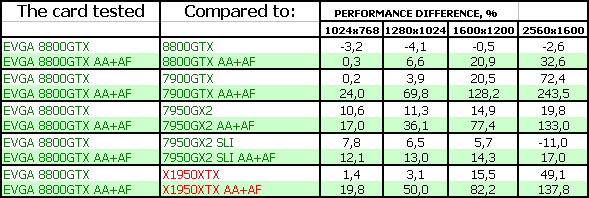 Note that the advantage of the EVGA product over the standard 8800 GTX grows together with the resolution. It evidently indicates benefits of the increased memory bandwidth due to the increased frequency (from 900 MHz to 1000 MHz). In other respects, the card from EVGA is a leader.
FarCry, Research (HDR)
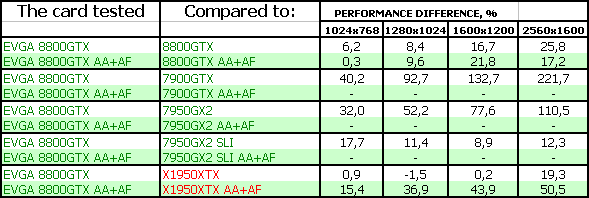 Well, the advantage of the new card is evident here as well. The fact that there is almost no difference between the cards without antialiasing and anisotropy indicates only that this game cannot load modern top accelerators. Performance is limited by system resources.
F.E.A.R.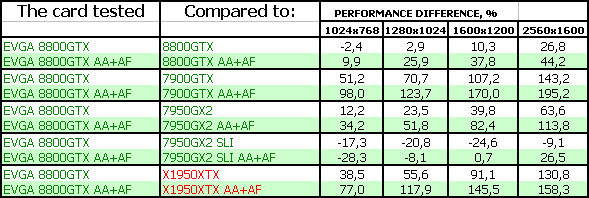 EVGA GeForce with a black cooler is again in the lead, the breakaway is large. It's only outperformed by the dual-GPU GeForce 7950GX2. But its total shader power is really great. Besides, there are 24+24=48 texture processors instead of 32, like in the 8800 GTX.
Splinter Cell Chaos Theory (No HDR)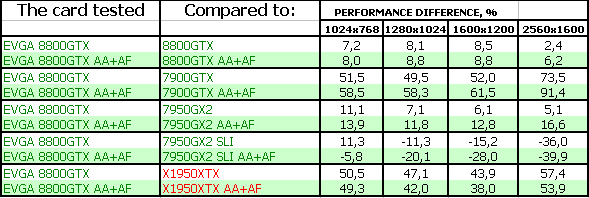 A similar situation. The unquestioning power of four (!) G71 processors is stronger than a single 8800 GTX, even if overclocked. Well, I think our readers will excuse such a trifle, considering the cost of Quad-SLI based on G71.
Splinter Cell Chaos Theory (HDR)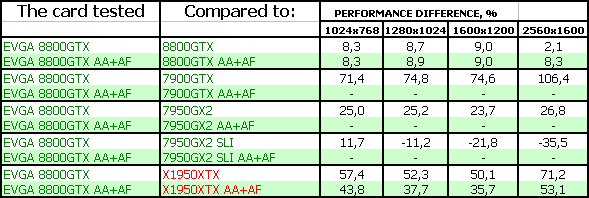 Enabled HDR has almost no effect on the layout of forces.
Call Of Juarez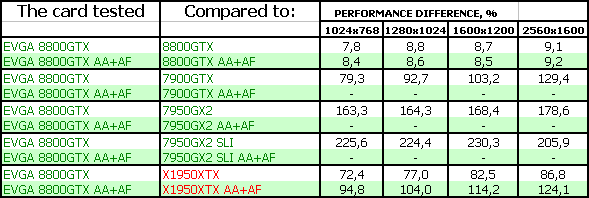 Wow! That's the most interesting case! Just look at the huge performance gain figures! But if you have a look at the diagrams, FPS results are not very high. This game kills even top accelerators with its complexity! BUT DON'T FORGET THAT 8800-SERIES CARDS WITH THE LATEST DRIVERS (mid February - Version 97.92) DEMONSTRATE GRAVE ARTIFACTS IN THIS GAME. SO IT'S TOO EARLY TO BE HOPEFUL. PERFORMANCE MAY DROP, WHEN THE BUG IS FIXED. Performance gains may become not very impressive. Company Of Heroes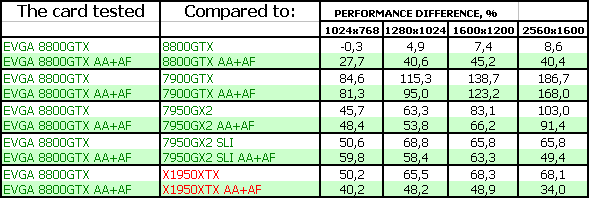 The tandem of 128 streaming processors and high operating frequency still gets its dividends, the EVGA products is beyond competition.
Serious Sam II (No HDR)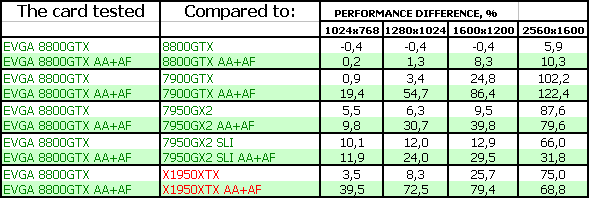 It's a similar situation. And again I ask beginners not to faint at the sight of zero or even negative performance gains! It only means that the potential of this video card in a given resolution and under a given load is much higher than allowed by system resources (that is the CPU lags behind this video card. Yes, it does! Even such a powerful one as Intel Core2 Duo X6800). And when nothing depends on a video card, results may vary within 2-5%. Both ways.
Serious Sam II (HDR)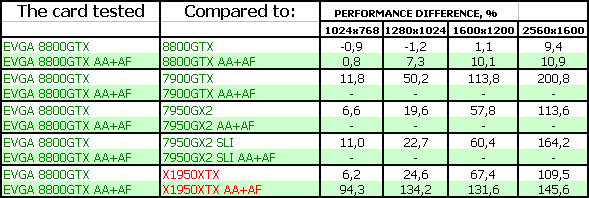 It's a similar situation. Even in case of HDR, no AA+AF, performance is still limited by the system resources.
Prey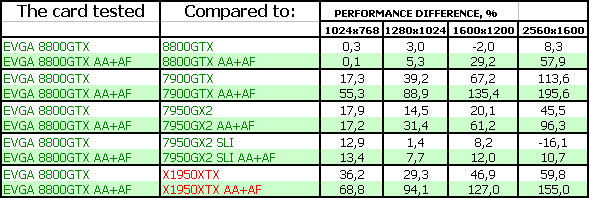
The same situation here. Besides, an OpenGL game with an engine from id Software will always favor NVIDIA products (for various reasons - fine-tuned NVIDIA drivers, optimizations of the game for Californian technologies).
3DMark05: MARKS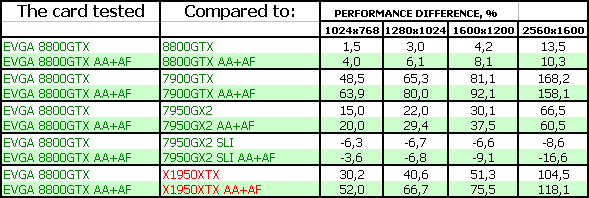
3DMark06: SHADER 2.0 MARKS
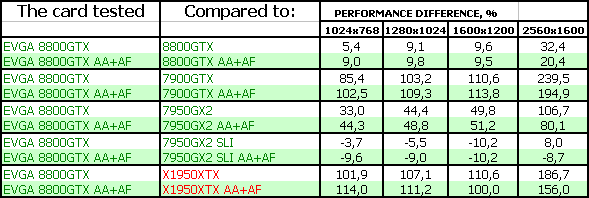
3DMark06: SHADER 3.0 MARKS
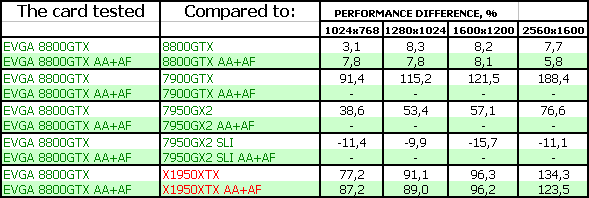
All the three synthetic tests demonstrate again that the EVGA product possesses exceptional shader power. It easily outperforms all its competitors.
Conclusions
EVGA e-GeForce 8800 GTX 768MB ACS3 Edition PCI-E is a very interesting product. If its real price is not raised too high versus regular 8800 GTX cards, we can safely recommend this product. But before you buy this product, you should make sure that such a card can be installed into your PC case and that the huge long black cooler will not touch some motherboard components. Palit GeForce 8800 GTX 768MB PCI-E is a standard 8800 GTX. The old game in the bundle is not a bonus. So the price will play a pivotal role. As a rule, cards from this company cost less than competing products. You shouldn't be afraid of problems with quality, etc. Remember once and for all: all GeForce 8800 GTX cards are manufactured by NVIDIA (it places orders). Neither Palit, nor EVGA, nor ASUS, nor Gigabyte, nor MSI (etc) have anything to do with their production. They just bundle the cards, package and label them. And that's it. On the whole, all the cards were stable, we had no gripes with their operation. Watch the prices! And don't say that you were not warned. All our conclusions may go to the dogs, if, for example, dealers raise the prices so that EVGA e-GeForce 8800 GTX 768MB ACS3 Edition PCI-E is twice as much as the regular 8800 GTX. All the advantages of this product will fade in this case, of course. By the way, speaking of the competition with RADEON X1950. Don't forget that the latter cards do not support DirectX 10 on the hardware level. And this technology belongs to the future. The choice is up to our readers, as always. We can only inform you about this or that product. But we do not give direct instructions which products to choose. And here is one more thing that will be repeated in each review. Having decided to choose a 3D accelerator on your own (a video card in your computer), you should understand that you change one of the key components of your system unit, which may require additional configuration for better performance or you may have to enable some functions to achieve higher quality. This is not an end product, it's just a component. So you should understand that you'll have to learn 3D graphics basics in order to get maximum performance from a new video card. And some graphics as well. If you don't want to deal with it, you shouldn't upgrade your computer on your own: you'd better buy ready PCs with preconfigured software (you'll also have technical support by your system integrator), or game boxes, where no configuration is required, everything necessary is already configured in a game. You can find more detailed comparisons of various video cards in our 3Digest.
The following card gets the Original Design award (February):

We'd like to thank
EVGA Russia and Victoria Nikolayeva PALIT and Alexander Lihtman for the provided video cards
Write a comment below. No registration needed!
|
Platform · Video · Multimedia · Mobile · Other || About us & Privacy policy · Twitter · Facebook Copyright © Byrds Research & Publishing, Ltd., 1997–2011. All rights reserved. | |||||||||||||||||||||||||||||||||||||||||||||||||||||||||||